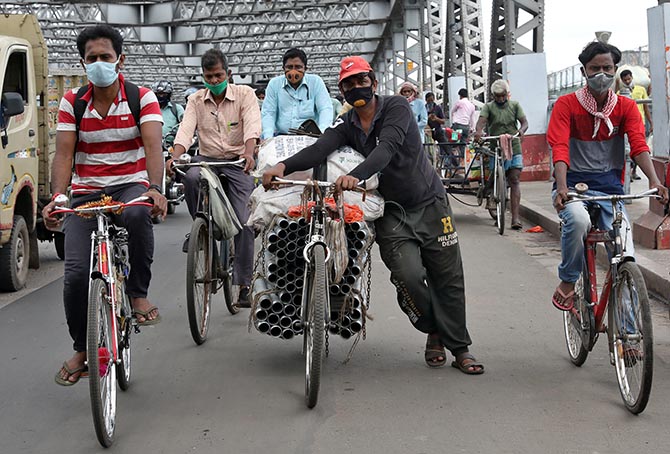'People are getting back to work.'
'The worst seems to be over.'
'It is very likely that the recovery is mostly among the informal, self-employed, workers who cannot afford to be away from work for too long,' notes Mahesh Vyas.

June 2020 is witnessing a very rapid fall in the unemployment rate.
After clocking 23.5 per cent in April and May, the unemployment rate first dropped to 17.5 per cent in the first week of June and then it took a steeper fall to 11.6 per cent in the second week.
This fall is almost as dramatic as the rise in unemployment when the lockdown began.
The fall in the unemployment rate is doubly appealing as it is accompanied by an increase in the labour participation rate (LPR).
The labour participation rate was 40.4 per cent in the week ended June 14.
The rate had fallen from 42.6 per cent in the week ended March 22, which was just before the lockdown, to 39.2 per cent in the first week of the lockdown, and the further to 36.1 per cent in the first week of April.
It continued falling till the week of April 26 when it reached its lowest level of 35.4 per cent.
The LPR has been recovering since the last week of April.
At 40.4 per cent in the week of June 14 it was not too far from its pre-lockdown level of around 42.7 per cent.
What is encouraging is the smart recovery from around 36 per cent in early May.
An increase in the LPR, along with a fall in the unemployment rate, implies an increase in the employment rate.
This, an increase in the employment rate, is the desired outcome.
It, in fact, is a far more important indicator of the health of the economy than the unemployment rate.
The employment rate in India has been rather low at just below 40 per cent.
This implies that less than 40 per cent of the population that is over 14 years of age is employed.
According to the World Bank database, the global average employment rate was 57.4 per cent in 2019.
In India, the employment rate fell by a massive 10 percentage points immediately upon the imposition of the lockdown.
The average employment rate during the three months ending February 2020 was 39.5 per cent.
This crashed to 29.9 per cent in the first week of lockdown, the week ended March 29. It kept falling to touch a low of 26.1 per cent in the week ended April 19.
The employment rate has been rising since early May 2020.
But the increase in the latest week of June 14 has been the smartest.
The employment rate shot up 3.3 percentage points from 32.4 per cent in the week ended June 7 to 35.7 per cent in the week ended June 14.
This is the largest weekly increase in the employment rate.
It is, however, not as sharp as the 9.2 percentage points fall in the week of March 29.
Evidently, while the fall in employment was very sharp and immediate, the recovery is much slower, even if the weekly gains are higher than ever before.
Much of the labour participation that was lost during the lockdown has been regained but the gain in employment has been lesser.
This is because the unemployment rate is still too high.
The labour participation rate in the week ended June 14 was 94.7 per cent of its level in the week just before the lockdown, which is the week of March 22.
However, the employment rate during the week ended June 14 was only 91.4 per cent of its pre-lockdown level.
The recovery in labour markets has been better in rural India than in urban India.
In rural India, labour participation has recovered to 95.4 per cent of its pre-lockdown-week (March 22) level and the unemployment rate is 32.2 per cent, higher than it was then.
In contrast, in urban India, labour participation has recovered less, at 93.2 per cent; and the unemployment rate is 51.3 per cent, higher than it was in the pre-lockdown-week.
The unemployment rate in urban India was 13.1 per cent in the week ended June 14.
This is a significant improvement over the 17.1 per cent unemployment rate in the preceding week or the 25 to 26 per cent unemployment recorded in towns in April and May 2020.
The unemployment rate had shot up to 30 per cent in urban regions early during the lockdown.
The fall to 13 per cent therefore is a respite particularly since it is accompanied by an increase in labour participation.
Rural India suffered a lesser spike in unemployment.
It remained mostly close to 20 per cent with a few spikes to 25 to 26 per cent.
The fall in the rural unemployment has been steeper.
It fell to 11 per cent in the week ended June 14.
The return of labour to participate in the economy and the simultaneous fall in the unemployment rate suggest that the lockdown is being lifted effectively across the country.
People are getting back to work. The worst seems to be over.
It is very likely that the recovery is mostly among the informal, self-employed, workers who cannot afford to be away from work for too long.
While we will know the composition of this recovery in early July, it is safe to expect that labour productivity will remain low in the midst of the ongoing partial lockdown.
Mahesh Vyas is managing director & CEO, Centre for Monitoring Indian Economy.









